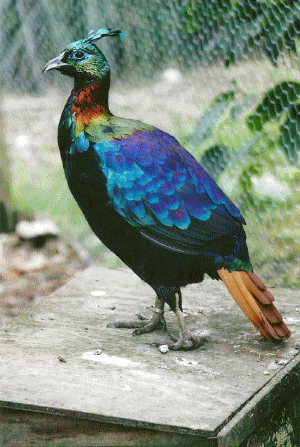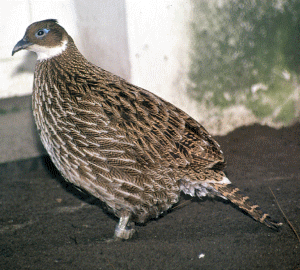 SKC Films Library SKC Films Library |
| SKC Films Library >> Science >> Zoology >> Birds >> Order Galliformes |
| Himalayan Monal Lophophorus impeyanus (aka Impeyan Pheasant, Impeyan Monal) The national bird of Nepal, the alternative name of Impeyan comes from Lady Impey, who first kept them in captivity.
Description The male possesses a wiry, metallic green head-crest that is absent in other monal species, as well as a chestnut brown tail, light brown wings and a white rump that is visible in flight. The head is bright green, the eyes ringed with blue and the neck reddish brown. At the nape is a yellowish patch which forms the top edge of the bluish black wings and the purplish black back. The breast is dark brown and the tail feathers are light brown. Females are much drabber, with overall dark brown feathers, except for a white throat and rump patch, and the bright blue circle around the eyes. Males average 22 to 25 inches in length, with females being considerably smaller.
Distribution and Habitat This species is found in the Himalayas from eastern Afghanistan to western China, into northeast India and southern Tibet. It spends the summer on grassy slopes above the tree line, and the winter in coniferous and mixed forests with a high proportion of rhododendrons and bamboo, but always above the 10,000 foot elevation line. Reproduction The breeding season begins in April. The male calls throughout the day until he attracts a female. After mating the female scrapes a nest in the ground and lays 3 to 5 eggs. The nest is usually located on a protected raised ledge on south or southeastern facing slopes of steep cliffs, but occasionally on a mass of boulders. The female incubates alone, but is guarded throughout the 27-day incubation period by the male, who also helps guard the chicks until they fledge. The young are completely independent after six months, and can breed by their second year. Social Behavior The Himalayan monal uses several different call types to express meaning to its mate, other birds in its foraging group, or intruding birds. Males generally associate in groups of two to three, but are somewhat territorial during the breeding season. In the winter females tend to associate in groups of about twenty individuals. Diet Like many other members of the Phasianidae family, the Himalayan monal uses its long, curved beak to dig into the soil to uncover seeds, tubers, shoots, berries, and insects. It is not uncommon for them to dig up to a foot into the ground in their search for food. Birds typically forage in small groups. Scientific Classification phylum Chordata SOURCES |
| SKC Films Library
>> Science
>> Zoology >> Birds >> Order Galliformes This page was last updated on June 21, 2017. |

